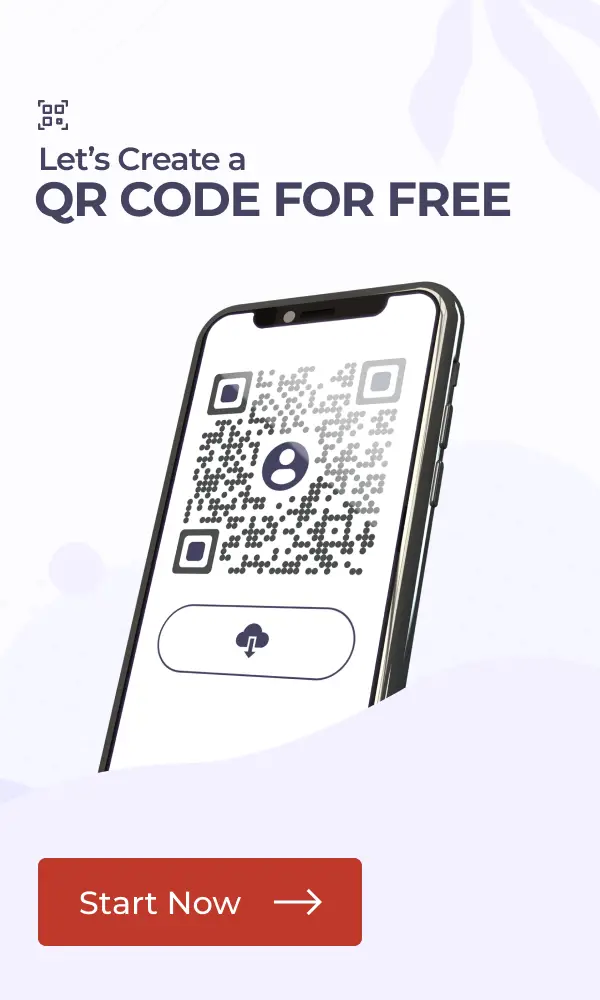QR Codes can be found everywhere, and so do the risks associated with it.
If you want a safe and secure experience for your customers when they use your QR Code, this article is for you.
Let’s dive deep and learn about QR Code security risks and how to tackle them!
A. What is a QR Code security risk
A QR Code security concerns any potential dangers that arise when scanning QR Codes. These include being directed to malicious websites, falling victim to phishing attacks, accessing harmful or inappropriate content, connecting to compromised networks, and making fraudulent payments.
B. What are the security risks of QR Codes
QRs can be a convenient tool, but they also can pose significant security risks. Let’s learn about some of them:
1. Malicious URLs
This type of QR security risk leads you directly to malicious websites, and downloads malware leading to phishing attacks.
Example: In 2021, a QR Code scam targeted German parking meters. Scammers placed stickers with malicious QR Codes over the real ones. When scanned, these codes directed users to a phishing website that downloaded malware onto their devices, resulting in stolen personal information and financial data.
2. Phishing attacks
These QRs lead you to websites that look authentic. They trick you into entering your sensitive information, like financial data.
Example: During the COVID-19 pandemic, a phishing scam involved QR Codes that appeared to link to vaccination appointment scheduling websites. Instead, these codes led users to fake websites designed to collect personal information, including Social Security numbers and insurance details.
3. QR Code replacement
Attackers can swap out authentic QRs with malicious ones in public places. This mis-guides users to harmful websites or actions.
Example: At a popular music festival, scammers replaced the official QR Codes on event posters with their own malicious codes. Festival-goers who scanned these codes were redirected to a website that stole their credit card information when they attempted to purchase event merchandise.
4. Embedded malicious data
Some QRs can contain malicious data that exploits vulnerabilities in QR readers or operating systems.
Example: A notable case involved a QR Code embedded in a promotional flyer for a popular electronics brand. When scanned, the QR Code executed a malicious script that exploited a vulnerability in certain Android devices, leading to unauthorized access and data theft.
5. Wi-Fi network configuration
QRs can configure your device to connect to a compromised network, which could lead to potential data interception.
Example: In a popular Asian airport, scammers placed QR Codes offering “free Wi-Fi” on tables and walls. When scanned, these codes automatically configure the devices to connect to a compromised network, allowing attackers to intercept sensitive data such as emails and login credentials.
6. Payment scams
In this scenario, attackers can replace real QRs with fake ones, diverting funds to unauthorized accounts.
Example: A small business owner in San Francisco discovered that the QR Codes on their restaurant tables had been replaced with fraudulent ones. Customers who scanned the codes to pay their bills were unknowingly sending payments to the scammers’ accounts instead of the restaurant’s.
C. How to prevent QR Code scams as a business
Businesses can prevent QR Code scams by implementing a few key strategies. Let’s learn more about them:
1. Educate customers
You can begin by raising awareness among customers about the critical risks when an unfamiliar QR is scanned. Provide them with clear guidelines on verifying QRs issued by your business.
Example: A popular retail chain sends out an email campaign educating customers about the risks of scanning unfamiliar QR Codes. They provide tips on how to verify the authenticity of QR Codes issued by the store, such as checking for specific security logos or confirming the URL displayed before scanning.
2. Use secure QR Code generators
When you use a reputable QR Code generator like Scanova, you are protected from all the malicious content.
Example: A restaurant chain decides to use Scanova for generating their menu QR Codes. By doing so, they ensure that customers are directed to a secure and trusted website, protecting them from potential phishing attacks or malware.
3. Secure display locations
Position QR Codes in secure, monitored areas to deter unauthorized access or tampering. Avoid placing them in uncontrolled environments.
Example: A fitness center installs QR Codes on their equipment for video tutorials. To prevent tampering, they place the codes in secure, monitored areas with regular checks by staff, avoiding placement in unsupervised or public spaces like locker rooms.
4. Verification systems
Implement systems for customers to verify QR Code destinations, ensuring links lead to legitimate business-related sites.
Example: An event organizer implements a system where attendees can verify the authenticity of QR Codes on their tickets by scanning a secondary, official QR Code posted on the event’s website. This ensures the links lead to legitimate sites related to the event.
5. Caution with shortened URLs
Exercise caution when using shortened URLs in QR Codes, ensuring they redirect to secure and trustworthy websites.
Example: A nonprofit organization uses QR Codes in their fundraising materials. They make sure that any shortened URLs embedded in the codes are thoroughly tested to ensure they redirect to their secure donation page, rather than potentially risky websites.
6. Enhanced website security
Ensure all websites linked to QR Codes utilize HTTPS for secure data transmission. Monitor sites regularly for any signs of compromise.
Example: A hotel chain ensures that all their QR Codes, which link to room service menus and local guides, direct users to HTTPS-enabled websites. They conduct regular security audits to detect and fix any vulnerabilities, maintaining a secure browsing experience for their guests.
Organizations building apps that use QR Codes should routinely uncover application vulnerabilities in code, pipelines, and runtime to prevent malicious redirects, data leaks, and insecure URL handling before deployment.
7. Alternative access options
Provide alternative methods for accessing information or services offered through QR Codes, such as direct web links or email.
Example: An educational institution provides QR Codes for accessing course materials but also offers direct web links and email options for students who may be wary of scanning QR Codes. This ensures everyone has safe access to the necessary information.
8. Prompt response to issues
Establish protocols for reporting suspicious QR Codes and promptly address any reported scams. Keep customers informed about potential risks and actions taken.
Example: A tech company sets up a dedicated hotline and online reporting system for customers to report suspicious QR Codes. When a potential scam is reported, they promptly investigate and update their customers about the situation, reinforcing trust and security.
D. Spotting a malicious QR Code: Tips for staying safe
Staying safe from malicious QRs involves a combination of vigilance and technical measures. Here are some of the following:
1. Trust the source
Stick to scanning QR Codes from trusted sources like official websites, apps, or directly from reputable businesses. Avoid codes from unfamiliar or suspicious sources.
2. Inspect the URL
Before scanning, check the URL embedded in the QR Code. Look for any unusual or mismatched domain names that don’t seem legitimate.
3. Check for integrity
Examine the QR for signs of tampering, such as altered graphics or design faults. A well-maintained QR is more likely to be safe.
4. Use reliable scanner apps
Opt for trusted QR Code scanner apps from reputable app stores. These apps often include security features that can detect and warn about potentially harmful codes.
5. Avoid shortened URLs
QR Codes with shortened URLs can obscure the destination website. Opt for codes displaying the full URL or use a URL expansion service before scanning if possible.
6. Be wary of promotions
QR Codes offering overly generous discounts or prizes may be attempts to lure you into scams. Verify such offers directly with the company through official channels.
7. Verify actions
Before doing any actions indicated by a QR Code, such as making a payment or entering personal information, confirm the request’s validity with the company or organization.
“Quishing” is a QR Code used in phishing emails. When a user scans the QR Code, he/she will then access the phishing website. Source: hkcert.org
E. Why QR Code security matters in a post-pandemic world
In today’s post-pandemic era, QR Code security is crucial for both businesses and consumers. Here’s why this matters:
1. Pervasive integration
QRs have been easily integrated into a variety of industries. They enable touchless interactions in retail, hospitality, healthcare, and more. Their ubiquitous use makes them excellent targets for cyber-attacks.
2. Essential transactions
QRs have become indispensable for a variety of transactions. This includes payments, ticketing, and remote access to vital information. Securing these transactions is critical for preventing financial losses and data breaches.
3. Enabling distant access
With the shift toward digital and distant interactions, QR Codes serve as portals to seamless service access from a distance. Providing security improves the reliability and trustworthiness of virtual transactions.
4. Exploitability
QR Codes in public places are easily tampered with, sending unwary consumers to phishing scams or harmful websites. As usage grows, so does the possibility of fraudulent activity targeting them.
5. Protecting personal data
Scanning QR Codes frequently require the exchange of personal information or access to sensitive information. Protecting sensitive data from unauthorized access is critical for preserving privacy and adhering to severe data protection requirements.
Equally important is managing other mobile vulnerabilities, like cookies that store browsing data and can be exploited if not properly secured. If you’re wondering how to manage iPhone cookies for better security and privacy, regularly reviewing your device settings is a smart practice.
6. Preserving brand integrity
A breach in QR security can harm a company’s brand. It also undermines customer trust. Implementing strong security measures is very critical. This helps maintain brand integrity and establish long-term client loyalty.
What our customers say about us:
F. The role of mobile security in protecting against QR Code risks
Mobile security plays a crucial role in protecting against QR Code risks. Let’s learn how they do just that:
1. Comprehensive scanning protection
Modern mobile security solutions include QR Code scanners equipped with advanced protections. These scanners can detect malicious URLs or tampered codes, preventing potential threats before they can harm your device.
2. Controlled app permissions
Secure mobile platforms ensure that apps must request permission before accessing QR Code functionalities. This prevents unauthorized apps from exploiting QR Codes for malicious activities.
3. Ensured data encryption
Mobile security protocols, such as HTTPS encryption, ensure that data transmitted through QR Codes remains secure against interception by unauthorized parties.
4. Educational empowerment
Effective mobile security initiatives include educating users about QR Code risks and best practices. This includes guidance on scanning codes only from trusted sources and verifying URLs before scanning.
5. Responsive recovery options
In case of a compromised QR Code leading to data loss or device compromise, mobile security features like remote wipe and recovery offer swift mitigation to minimize potential damage.
6. Enhanced authentication layers
Many mobile security solutions integrate multi-factor authentication (MFA), adding an extra layer of protection when accessing sensitive information via QR Codes.
G. Educating employees on QR Codes cyber security
It is very vital for a business to educate its employees so that they can safeguard themselves against potential threats. Here’s how you can implement the strategies:
1. Guidelines for safe usage
Provide straightforward guidelines on best practices for using QR Codes. Stress the importance of scanning only from trusted sources and verifying URLs before scanning. Highlight the risks of scanning codes in public areas where they could be compromised.
2. Utilizing secure tools
Encourage employees to use reputable QR Code scanner apps equipped with robust security features. These tools can detect and alert users about suspicious URLs or tampered codes, preventing potential threats before they escalate.
3. Tailored training
Customize training sessions to suit different roles within the company. For instance, emphasize QR Code security in financial transactions for finance teams and promotional materials for marketing teams.
4. Keeping employees informed
Regularly update employees on new QR Code scams and security protocols through ongoing training sessions, newsletters, or internal communications. This keeps security practices top of mind and reinforces vigilance.
5. Practical drills
Conduct simulated phishing drills involving QR Codes to gauge employee awareness and responses. Use these exercises to reinforce training and identify areas needing improvement.
In January 2022, the FBI released a warning that cybercriminals may tamper with QR Codes to direct victims to malicious websites. Scammers often look to the latest trends for new cybercrime tactics. Source: ic3.gov
H. Future trends in QR Code security
Let’s see how the future of QR Codes will shape up and help in mitigating the QR Code security risks:
1. Advanced authentication methods
Anticipate the rise of more secure QR Code authentication techniques, such as biometric verification or multi-factor authentication (MFA). These methods will strengthen access controls and protect sensitive information.
2. Compliance standards
Continued focus on regulatory compliance, particularly in sectors handling sensitive data like finance and healthcare. Adhering to strict standards will drive innovation in QR Code security practices.
3. User education
Continued efforts to educate users about QR Code security dangers and best practices. Increasing awareness allows people to make more educated decisions and protect themselves from QR Code-related scams.
4. IoT integration
As QR Codes become more integrated with IoT devices and smart apps, it will be critical to ensure comprehensive security measures across interconnected systems to avoid potential vulnerabilities.
5. Global guidelines
Development of global standards and guidelines for QR Code security to ensure consistent practices and interoperability across different platforms and regions.
6. Privacy protection
Heightened emphasis on safeguarding user privacy during QR Code interactions, particularly regarding the collection and use of personal data. Adhering to stringent privacy regulations will influence QR Code security strategies.
Brands that trust us:
Summing Up
QR Codes are one of the best tools for both businesses and consumers. However, they carry their own set of security vulnerabilities.
We hope that through this blog, you’ll be informed and educated about the security risks of QR Codes and implement discussed ways to overcome them.
If you have any questions, feel free to ask them in the comment section!


